|
"Understandably, the
search for graphic portrayals of Pleistocene megafauna, concerned
primarily with the identification of probosideans, has led to an
assortment of claims that range from the absurd to the potentially
plausible and powerfully persuasive."--------2011,
Ekkehart Malotki & Henry D. Wallace, "Columbian Mammoth
Petroglyphs From The San Juan River Near Bluff, Utah, United States."
Rock Art Research 2011, Vol. 28, No. 2, pp. 143-144.
"The
authentication of two petroglyph depictions of mammoths along Utah's San
Juan River clearly confirms the consensus of Late Pleistocene
researchers that Paleoamerican humans lived side by side with
now-extinct megafauna in the fossil and archaeologically rich region of
southeastern Utah."----2011, Ekkehart
Malotki & Henry D. Wallace, "Columbian Mammoth Petroglyphs From
The San Juan River Near Bluff, Utah, United States." Rock Art
Research 2011, Vol. 28, No. 2, pp. 143-144.
"Rock art sites have the special feature of
being long-term in situ artifacts. Furthermore, as Schaafsma (1985:241)
points out, rock art sites are not "destroyed in the course of being
studied," as are subsurface sites that require excavation and hence
destruction of the physical record."---------2000,
Carol Diaz-Granados and James R. Duncan, "The Petroglyphs and
Pictographs of Missouri," p. 2.
"Vast numbers of petroglyphs appear on slabs,
boulders, and broad rock faces throughout America, displaying great
diversity in manner of execution and finish. Hammerstones of ordinary
form were doubtless employed, but pointed pick-like implements, hafted
or unhafted, were better suited to the purpose.."------1919,
W. H. Holmes, "Handbook of Aboriginal American Antiquities," Part I
Introductory The Lithic Industries, Bureau Of American Ethnology,
Bulletin 60, p. 335.
"The form of picture-writing known as the petroglyph is
of world-wide distribution and is common over most of North America.
Petroglyphs may be pecked or incised, or painted; occasionally they are
rendered both permanent and conspicuous by being first incised and then
painted. They appear on sea-worn boulders, on glacier-polished rocks, on
canyon cliffs, and within caves."----1912,
Fredrick Webb Hodge, "Handbook Of North American Indians," Bureau of
American Ethnology, Part 2, Bulletin 30, p. 244.
"To
us (a current native American Indian
perspective) these petroglyphs are not the remnants of some long lost civilization
that has been dead for many years...they are part of our living culture.
What is stored in the petroglyphs is not written in any book or to be
found in any library. We need to return to them to remind us of who we
are and where we came from, and to teach our own sons and daughters of
it. (Herman Agoyo, San Juan Pueblo,
New Mexico)"----1998,
Sabra Moore, "Petroglyphs Ancient Language / Sacred Art," p. 11.

TWO COLUMBIAN MAMMOTH
PETROGLYPHS
UPPER SAND ISLAND ROCK ART
SITE
SOUTHEASTERN UTAH
Carved and painted images on stone can be found
on ancient sites all over the world. They represent some of the most
important evidence archaeologists have to interpret cultural history.
These visual images represents the photography of their time. The
downside is their figural identity can be difficult to prove, they can
not be carbon dated, and you can't bring back the ancient minds of the
artist/craftsmen who made them. Most petroglyph imagery can be
identified and assigned to one of the local iconographic styles that
will identify the culture and time they lived.
It's the sites that are uniquely different in style and age that cause the most
controversy and a great effort on behalf of researchers to prove. This article describes two such examples. They are images that
appear to represent Ice Age animals in the form of Columbian mammoths. |
|
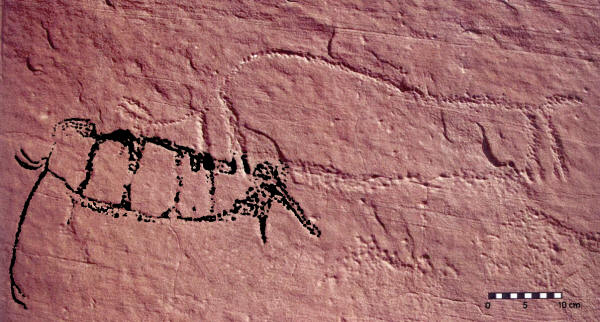
PHOTO AND DRAWING COMPUTER ALTERED BY
PETE BOSTROM----WITH PERMISSION OF EKKEHART MALOTKI
CLICK ON PICTURE FOR LARGER IMAGE
MAMMOTH 1
UPPER SAND ISLAND ROCK ART SITE
SOUTH EASTERN UTAH
This picture shows an area of "rock
art" on the Upper Sand Island Rock Art site in south eastern Utah.
The pattern is thought to be very early and date to sometime between
the Pleistocene-Holocene transition period, approximately 13,300 to
12,500 years ago. It represents a portion of a cluster of
petroglyphs that are described as a panel. Although the highlighted
area in this picture appears "insect-like" there are specific
reasons why the image may represent a mammoth. The highlighted image
is designated as mammoth 1 because it was the first of two mammoth
designs that were discovered in the panel group. The design above
mammoth 1 is described as a bison. Both the mammoth and bison were
formed by pecking, incising, and scraping. They measure
approximately 87cm (34.25 inches) from the tip of the mammoth's tusk
to the tip of the bison's tail. The cut marks are significantly
weathered and re-varnished over most of their surfaces. A
comparison to more recent Ute horse petroglyphs located nearby show
an obvious age difference between the two. Magnification of the cut
marks indicate that the mammoth and bison were not recently made or
altered and that the bison was made after the mammoth.
Mammoth 1 has several design characteristics that suggests it
may represent a Columbian mammoth (Mammuthus columbi).
The most obvious features are the domed head, tusks, and trunk. The
domed head is clearly formed with a concentrated area of pecking
marks. The raised area behind the head may represent a raised
shoulder that is also a descriptive trait of mammoth anatomy.
Mastodons did not have these two identifiable features. Mammoth 1
also has two parallel tusks that extend outward from an area lower
on the head, unlike horns that would attach higher up near the top
of the head. The trunk is impressive for its length and for the fact
that it does have a bifurcated end that may represent "fingers."
Many Old World Paleolithic cave sites, such as Chauvet in France,
illustrate the ends of woolly mammoth trunks with one long and one
short grasping "finger." The shorter one is referred to as the
thumb. Although not very impressive, mammoth 1 has one front and two
back "stick-like" legs. If there was a tail, it appears that it may
have been removed by the addition of the above bison image.
Mammoth 1 has one design trait that does seem odd. The vertical body segmentation
makes the image look insect-like. Linear style quadrupedal figures
in both horizontal and vertical forms are known in the area. But
this style dates much later to the Middle Holocene and is not
similar to the design pattern in mammoth 1. |
|
|
The Upper Sand Island Rock Art site is located about a
kilometer upstream from a more well known petroglyph site called the
Sand Island site. They are located in southeastern Utah along the San
Juan River. Archaeologists first recorded the Upper Sand Island Rock Art site in 1985. The petroglyph designated
as mammoth 1 was first shown to Malotki in the early 1990's. The image
is part of a ten foot wide panel of several petroglyphs that researchers
have assigned to a very early date. They are situated approximately five
meters
above ground level. |
|
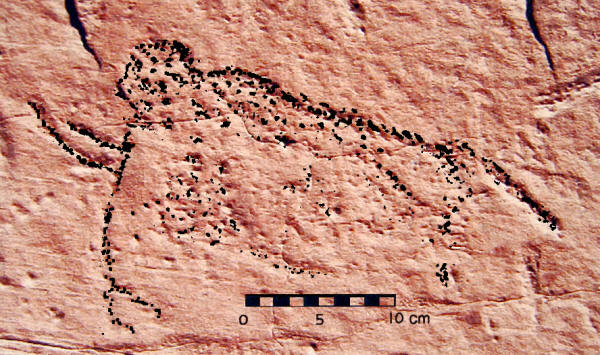
PHOTO AND DRAWING COMPUTER ALTERED BY
PETE BOSTROM----WITH PERMISSION OF EKKEHART MALOTKI
CLICK ON PICTURE FOR LARGER IMAGE
MAMMOTH 2
UPPER SAND ISLAND ROCK ART SITE
SOUTH EASTERN UTAH
This picture shows a highlighted image of the petroglyph referred to
as mammoth 2.
It was discovered, from photographs, by Robert Ciaccio who assisted
researchers with illustrations of the panel of early period
petroglyphs. Mammoth 2 is situated approximately 8 feet (2.5 meters) to the left
of mammoth 1 and about 5 meters above ground level. This figure
appears more "mammoth-like" than mammoth 1 mainly because it does
not have the vertical segmentation. It's
domed head, tusks, trunk, and stick-like legs are
very similar to mammoth 1. It also has a long trunk with a
bifurcated end that seems to represent the two finger-like
extensions most probosideans have. This image would fit quite well in
a
European cave painting. It measures about 13 3/4 inches (35cm)
from tusk to tail. |
|
|
The age of the Upper Sand Island mammoth petroglyphs is an estimate taken from
visual comparisons of surface re-varnishing within the cut marks. More recent petroglyphs found nearby
are not as heavily patinated. Based on the identification of the
petroglyphs as mammoths and the degree of surface re-varnishing within
the cut marks, the mammoth panel is described as being made sometime
between the Pleistocene and the Holocene periods. An estimated date of
between 13,300 and 12,500 years ago has been suggested. |
|
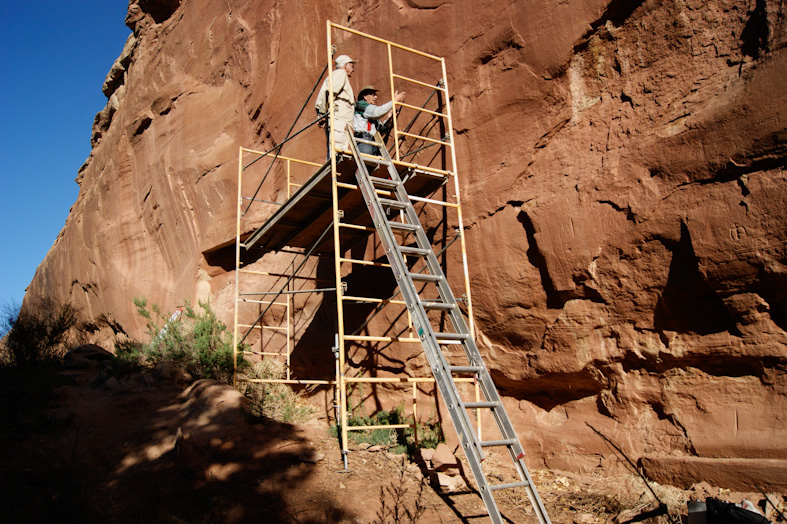
IMAGE USE WITH PERMISSION OF EKKEHART MALOTKI
SCAFFOLDING & LADDER TO
ACCESS THE
MAMMOTH PETROGLYPHS
UPPER SAND ISLAND ROCK ART SITE
SOUTH EASTERN UTAH
This picture shows how difficult it
is to access the Upper Sand island Rock Art site's Paleo panel. This
is the area where the two mammoth figures are located. The people
observing the glyphs are professors Ekkehart Malotki and Jean
Clottes of France. Jean Clottes is one of the best known Ice Age art
specialists in the world. His comment about the mammoth images is,
"---the proboscidean depictions are mammoths "without the slightest
doubt." Numerous paleontologists also agree with him. |
|
|
Mammoth 1 is located on the right side of the panel and
mammoth 2 is located at far left. Mammoth 1 has several design characteristics that suggests it
may represent a Columbian mammoth (Mammuthus columbi).
The most obvious features are the domed head, tusks, and trunk. The
domed head is clearly formed with a concentrated area of pecking
marks. The raised area behind the head may represent a raised
shoulder that is also a descriptive trait of mammoth anatomy.
Mastodons did not have these two identifiable features. Mammoth 1
also has two parallel tusks that extend outward from an area lower
on the head, unlike horns that would attach higher up near the top
of the head. The trunk is impressive for its length and for the fact
that it does have a bifurcated end that may represent "fingers."
Many Old World Paleolithic cave sites, such as Chauvet in France,
illustrate the ends of woolly mammoth trunks with one long and one short
grasping "finger." The shorter one is referred to as the thumb. Although
not very impressive, mammoth 1 has one front and two back "stick-like"
legs. If there was a tail, it appears that it may have been removed by
the addition of the bison image that was put in place after the mammoth. |
|
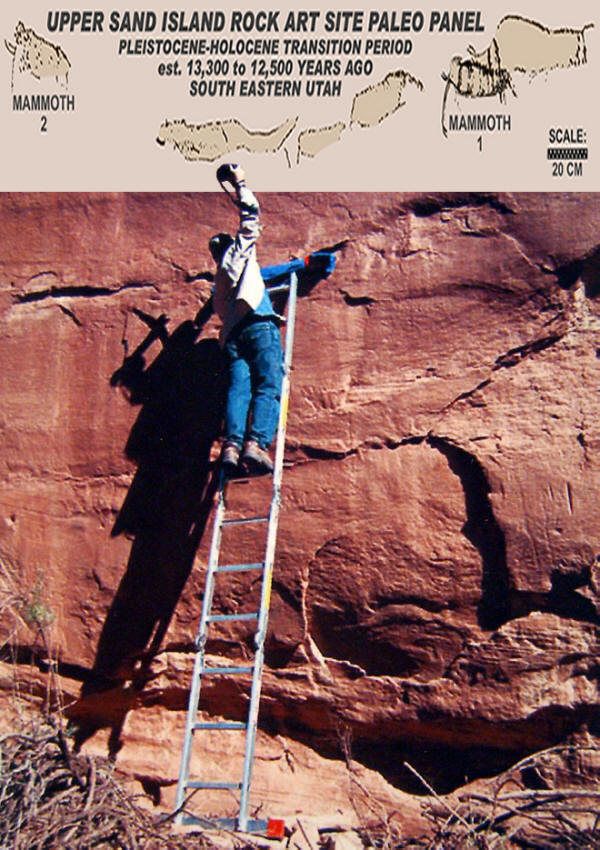
PHOTO AND DRAWING COMPUTER ALTERED BY
PETE BOSTROM----WITH PERMISSION OF EKKEHART MALOTKI
COMPUTER IMAGE SHOWING
AREA WHERE
MAMMOTH PETROGLYPHS AND OTHER
PALEO ROCK ART IS LOCATED
UPPER SAND ISLAND ROCK ART SITE
SOUTH EASTERN UTAH
This picture shows how high the
mammoth petroglyphs are located above current ground level. The
panel of petroglyphs are just above the person taking the pictures.
From end-to-end the distance is about 10 feet. |
|
|
Mammoth 1 has one design trait that does seem odd. The
vertical body segmentation produces an insect-like appearance. Linear style quadrupedal
figures in both horizontal and vertical forms are known in the area and
they date much later to the Middle Holocene. But this more recent form
is not at all similar to the style found on mammoth 1. |
|
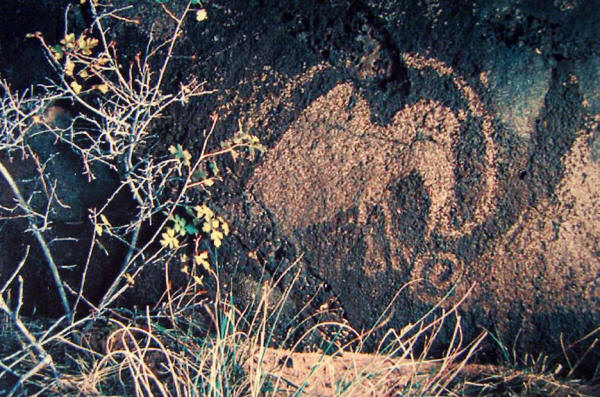
THIS IMAGE USED WITH PERMISSION OF EKKEHART MALOTKI
MAMMOTH-LIKE PETROGLYPH
WITH CLOVEN HOOFS
SUWANEE, NEW MEXICO
This petroglyph is located near Suwanee,
New Mexico. It illustrates how difficult it can be to identify some types of animals.
Although this figure seems to represent a mammoth with a trunk,
tusks, domed head, and a raised area at the shoulder, researchers
point to its cloven hoofs as
probably belonging to a bison. |
|
|
Mammoth 2 appears
more "mammoth-like" than mammoth 1 mainly because it does not have the vertical
segmentation. It's
domed head, tusks, trunk, and stick-like legs are
very similar to mammoth 1. Mammoth 2 also has a long trunk
that has a bifurcated end that seems to represent the two finger-like
extensions most probosideans have. This image would fit quite well in a
European cave painting of a mammoth. Mammoth 2 measures about 13 3/4 inches (35cm)
from tusk to tail. |
|
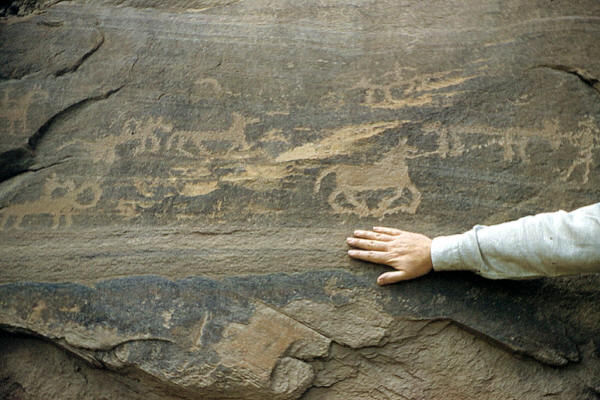
PICTURE FROM LITHIC CASTING LABS COLLECTION OF IMAGES
CLICK ON PICTURE FOR LARGER IMAGE
LATE PERIOD PETROGLYPHS
ILLUSTRATING HORSES
CANYON DE CHELLY
ARIZONA
Some petroglyphs are very easy to
identify. This picture shows some very late period petroglyphs in
the form of horses and humans. Image identification and microscopic
observation of surface varnish within the
cut marks are just about all researchers have to help date these sites. |
|
|
There has been some criticism of the early date estimates and
imagery identification for the mammoth petroglyphs. On the lighter
side, they have been identified as transformational moths by one person
and another argues that the image identification is nothing more than a
Rorschach test. More serious arguments involves microerosion dating of
the cut marks (only on the bison) and the geological position of the
rock wall at the time when living mammoths walked the land. But these
last two arguments are defended by Malotki, Vandenberghe & Mees (2014)
for reasons that there is still not enough data to support them in an
absolute scientific way. |
|
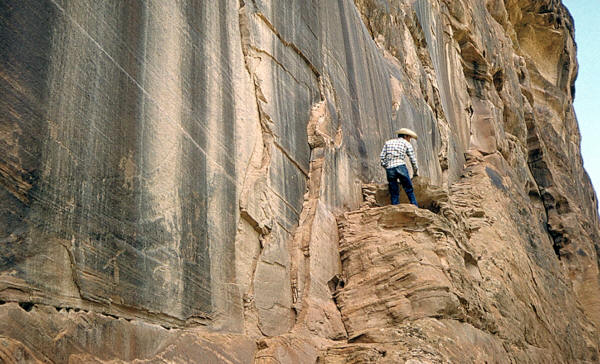
PICTURE FROM LITHIC CASTING LABS COLLECTION OF IMAGES
CLICK ON PICTURE FOR LARGER IMAGE
CLIFF FACE WITH
PETROGLYPHS
CANYON DE CHELLY
ARIZONA
Unlike the painted images that were placed out-of-sight and deep
with European caves, many petroglyphs were placed in locations that
were meant to be seen. They were placed high on sheer cliff
walls. As this picture shows, some petroglyphs took a real balancing
act to apply. |
|
|
These human
expressions of pictorial mammoth forms seem to represent some of the
best visual images from North America's Ice Age. Although modern
interpretation of an ancient's creation won't always be considered
"absolute proof," the Upper Sand Island mammoths, especially mammoth 2,
does look like a mammoth. If more of these images do exist more
discoveries are likely to happen. Mammoth hunting in today's modern
world may seem odd but it's a good bet there's a mammoth number 3 out
there somewhere. |
|
"REFERENCES"
1912, Hodge, Fredrick Webb, "Handbook
Of North American Indians," Bureau of
American Ethnology, Part 2, Bulletin 30.
1919, Holmes, W. H. "Handbook of Aboriginal American
Antiquities," Part I Introductory The Lithic Industries, Bureau Of
American Ethnology, Bulletin 60.
1998, Moore, Sabra, "Petroglyphs Ancient Language / Sacred
Art."
2000, Carol Diaz-Granados and James R. Duncan, "The
Petroglyphs and Pictographs of Missouri."
2011, Malotki, Ekkehart & Wallace, Henry D., "Columbian Mammoth
Petroglyphs From The San Juan River Near Bluff, Utah, United States."
Rock Art Research 2011, Vol. 28, No. 2.
2013, Clottes, Jean, "Two Petroglyphs Of Probosideans At Upper Sand
Island, Bluff, Utah," International Newsletter On Rock Art, No. 67.
2014, Malotki, Ekkehart, Vandenberghe, Dimitri, & Mees Florias, "The
Significance Of The Upper Sand Island Mammoth Depictions Near Bluff,
Utah, USA," source, academia.edu.
2015 Personal Communication with Ekkehart Malotki,
Professor emeritus of languages at Arizona University.
|
|
RECENT
LISTINGS HOME
ORDERING |